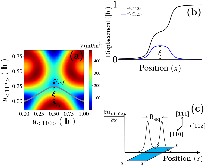Analytic model of the -surface deviation and influence on the stacking fault width between partial dislocations
- Los Alamos National Lab. (LANL), Los Alamos, NM (United States)
The stacking fault width (R$$_{eq}$$) between partial dislocations within an FCC crystalline lattice characterizes the onset of numerous plastic flow mechanisms, as well as the relationship between material strength and grain size. Continuum models traditionally consider a complete unit of dislocation slip (b) along the $$\langle{110}$$$$\rangle$$ direction distributed between two discrete partial dislocations, each with a fixed partial Burgers vector (bp), which bound a stacking fault. Across the stacking fault, the vectorial slip is assumed to be constant, yielding a constant intrinsic stacking fault energy density, $$\gamma$$$$_{isf}$$ Here, we demonstrate that the vectorial displacement path taken in accomplishing a complete unit of slip (b) deviates from the expected displacement path containing the local minima, $$\gamma$$$$_{isf}$$ leading to a correction in the nominally derived stacking fault width. The magnitude of the correction depends on both the net orientation of the dislocation within the lattice, and also the degree of relaxation of each partial Burgers vector along the $$\langle{\bar{1}12}$$$$\rangle$$ direction. We derive a simple analytic model for the corrected stacking fault width, explicitly accounting for the deviation, by introducing a variable ξ (0 < ξ < 1), which governs the magnitude of each partial dislocation component along the $$\langle{\bar{1}12}$$$$\rangle$$ direction. Significantly, our model predicts a correction to R$$_{eq}$$ of ~$$\mathscr{O}$$ (|b|) for the nominally screw dislocation, and has no noticeable influence on nominally edge dislocations. We apply our model towards computing the stacking fault width of several FCC metals, and demonstrate excellent agreement both with our own numerical data as well as that obtained from ab initio and Molecular Statics (MS) methods within the literature. Lastly, the results from this study demonstrate that, upon judicious application, discrete linear elastic models are successful in reproducing elastic interactions as computed from higher fidelity models on the spatial scale of metallic dislocation cores.
- Research Organization:
- Los Alamos National Lab. (LANL), Los Alamos, NM (United States)
- Sponsoring Organization:
- USDOE Laboratory Directed Research and Development (LDRD) Program
- Grant/Contract Number:
- 89233218CNA000001; ER20160156; ER20170679; AC52-06NA25396; 20170679ER
- OSTI ID:
- 1524373
- Alternate ID(s):
- OSTI ID: 1548632
- Report Number(s):
- LA-UR-17-29245
- Journal Information:
- Computational Materials Science, Vol. 147, Issue C; ISSN 0927-0256
- Publisher:
- ElsevierCopyright Statement
- Country of Publication:
- United States
- Language:
- English
Web of Science
Phase-field-based calculations of the disregistry fields of static extended dislocations in FCC metals
|
journal | February 2019 |
A comparison of different continuum approaches in modeling mixed-type dislocations in Al
|
journal | July 2019 |
An iterative scheme for the generalized Peierls–Nabarro model based on the inverse Hilbert transform
|
journal | December 2019 |
Similar Records
Global Polarization of and Hyperons in Collisions at
Atomistically-informed Dislocation Dynamics in fcc Crystals





